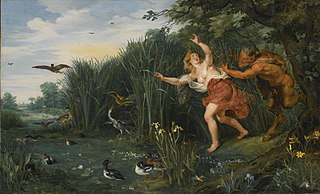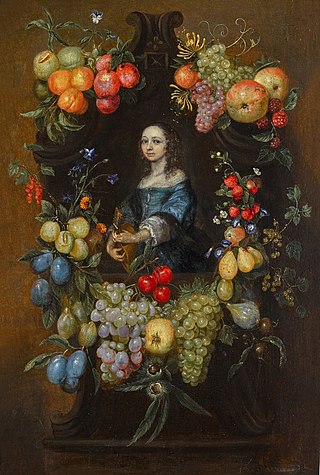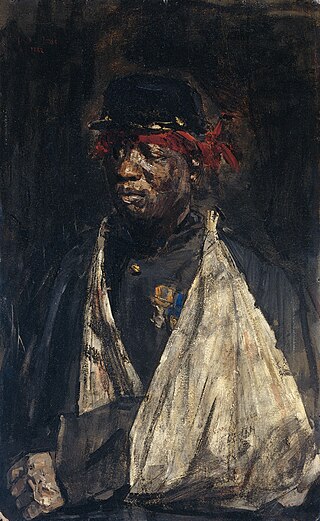
Jan Brueghelthe Younger was a Flemish Baroque painter. He was the son of Jan Brueghel the Elder, and grandson of Pieter Bruegel the Elder, both prominent painters who contributed respectively to the development of Renaissance and Baroque painting in the Habsburg Netherlands. Taking over his father's workshop at an early age, he largely painted the same subjects as his father in a style which was similar to that of his father. He gradually was able to break away from his father's style by developing a broader, more painterly, and less structured manner of painting. He regularly collaborated with leading Flemish painters of his time.

The Caravaggisti were stylistic followers of the late 16th-century Italian Baroque painter Caravaggio. His influence on the new Baroque style that eventually emerged from Mannerism was profound. Caravaggio never established a workshop as most other painters did, and thus had no school to spread his techniques. Nor did he ever set out his underlying philosophical approach to art, the psychological realism which can only be deduced from his surviving work. But it can be seen directly or indirectly in the work of Rubens, Jusepe de Ribera, Bernini, and Rembrandt. Famous while he lived, Caravaggio himself was forgotten almost immediately after his death. Many of his paintings were re-ascribed to his followers, such as The Taking of Christ, which was attributed to the Dutch painter Gerrit van Honthorst until 1990.

Simon Vouet was a French painter who studied and rose to prominence in Italy before being summoned by Louis XIII to serve as Premier peintre du Roi in France. He and his studio of artists created religious and mythological paintings, portraits, frescoes, tapestries, and massive decorative schemes for the king and for wealthy patrons, including Richelieu. During this time, "Vouet was indisputably the leading artist in Paris," and was immensely influential in introducing the Italian Baroque style of painting to France. He was also, according to Pierre Rosenberg, "without doubt one of the outstanding seventeenth-century draughtsmen, equal to Annibale Carracci and Lanfranco."

David Teniers the Younger or David Teniers II was a Flemish Baroque painter, printmaker, draughtsman, miniaturist painter, staffage painter, copyist and art curator. He was an extremely versatile artist known for his prolific output. He was an innovator in a wide range of genres such as history painting, genre painting, landscape painting, portrait and still life. He is now best remembered as the leading Flemish genre painter of his day. Teniers is particularly known for developing the peasant genre, the tavern scene, pictures of collections and scenes with alchemists and physicians.

Philip Fruytiers (1610–1666) was a Flemish Baroque painter and engraver. Until the 1960s, he was especially known for his miniature portraits in watercolor and gouache. Since then, several large canvases signed with the monogram PHF have been ascribed to him. These new findings have led to a renewed appreciation for his contribution to the Antwerp Baroque.

Jan Cossiers was a Flemish painter and draughtsman. Cossiers' earliest works were Caravaggesque genre works depicting low life scenes. Later in his career he painted mostly history and religious subjects as well as portraits. Cossiers was one of the leading painters in Antwerp after Rubens' death in 1640 and one of the most original colorists in 17th-century Flanders. He was an accomplished draughtsman who created some sensitive portrait drawings executed in a very varied and fluid manner.
Albert Eckhout (c.1610–1665) was a Dutch portrait and still life painter. Eckhout, the son of Albert Eckhourt and Marryen Roeleffs, was born in Groningen, but his training as an artist and early career are unknown. A majority of the works attributed to him are unsigned. He was among the first European artists to paint scenes from the New World. He was in the entourage of the Dutch governor-general of Brazil, Johan Maurits, Prince of Nassau-Siegen, who took him and fellow painter Frans Post to Dutch Brazil to have them record the country's landscape, inhabitants, flora and fauna. Eckhout is also famous for his still-life paintings of Brazilian fruits and vegetables. His paintings were intended for decoration in a domestic context.

Charles Sedelmeyer was an Austrian and French art dealer, collector, and publisher active in Paris from 1866, with premises at 6 rue de la Rochefoucauld.

Abraham de Vries was a Dutch painter who was one of the leading portraitists of his age. As he led a peripatetic lifestyle and worked in France, Antwerp and the Dutch Republic his stylistic qualities are difficult to pin down.

Isabella Brant, a portrait drawing, was executed in Antwerp around 1621, by Flemish artist and diplomat, Peter Paul Rubens (1577–1640). Brant (1591–1626) was Rubens' first wife and modelled for some of his portraits until her untimely death in 1626. The portrait is drawn in black and red chalk with white heightening on brown wash paper.

Charles Emmanuel Biset or Karel Emmanuel Biset was a Flemish painter who had a peripatetic career working in various cities and countries including his hometown Mechelen, Paris, Annonay, Brussels, Antwerp and Breda. He worked in many genres including genre scenes of interiors with merry companies and gallery paintings, history painting, still life and portraiture.

Antoon Sallaert or Anthonis Sallaert (1594–1650) was a Flemish Baroque painter, draughtsman and printmaker who was active in Brussels. Sallaert produced many devotional paintings for the Brussels court of Archdukes Albert and Isabella as well as for the local churches. Sallaert was an innovative printmaker and is credited with the invention of the monotype technique. He was an important tapestry designer for the local weaving workshops.

Carstian Luyckx, also known as the Monogrammist KL, was a Flemish painter and draughtsman who specialized in still lifes in various subgenres including flower still lifes, fruit still lifes, fish still lifes, pronkstillevens, vanitas still lifes, hunting pieces and garland paintings. He also painted animals and a few genre scenes. After starting his career in Antwerp he is believed to have worked later in France.

Catarina Ykens or Catarina Ykens (I) (née Floquet) (1608/1618 – after 1666) was a Flemish still life painter. She is known for flower and fruit garland paintings and vanitas paintings.

The Rape of Ganymede is a painting by the Flemish Baroque painter Peter Paul Rubens produced between 1636 and 1638 painting for the Spanish king Philip IV of Spain's hunting lodge. The painting is based on a story recounted in classical poet Ovid's Metamorphoses. It depicts the moment when the Roman supreme god Jupiter disguised as an eagle catches the young shepherd Ganymede and lifts him into the air. It is in the collection of the Museo del Prado in Madrid. The dramatic scene gave Rubens ample opportunity to show his skill in depicting a lively scene and the nude.

Portrait of Dom Miguel de Castro, Emissary of Congo is a 1643 painting by the Dutch Golden Age painter Jasper or Jeronimus Becx. It was earlier attributed to Albert Eckhout.

Jan Kooi was a Dutch KNIL military officer from Ghana.

Portrait of a Wounded KNIL Soldier is an Amsterdam impressionist portrait painting by Isaac Israëls, signed and dated to 1882. It has been in the Rijksmuseum since 2000.

Black Woman with Child is a circa 1650 full-length portrait painting by Albert Eckhout. It is in the collection of the National Museum of Denmark, in Copenhagen.

The Sibyl Agrippina is a circa 1630s oil painting of a Black woman in the guise of the Sibyl Agrippina. The painting is one of a series of Sybils by Jan van den Hoecke, only recently being re-attributed after being known as an early portrait of an African woman by Abraham Janssens. It is held in the Museum Kunstpalast in Düsseldorf.






















